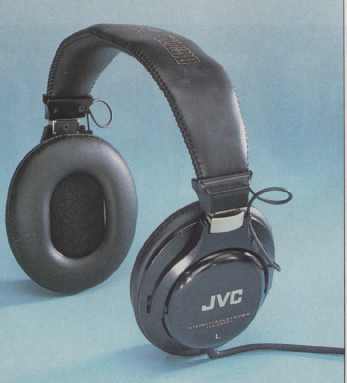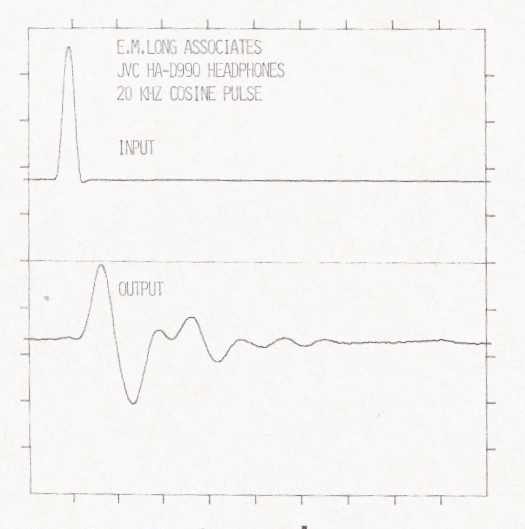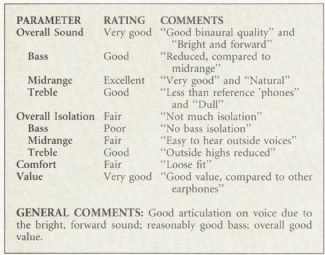|
|
The HA-D990s were, until recently [early 1993], JVC’s top-of-the-line non-wireless headphones. The cord’s gold stereo plug is an immediate indication of their high quality, intended to catch the eyes of audiophiles who know the value of good, corrosion- free connections. Oxygen-free cop per wires are used for the cord and copper-clad aluminum wire for the voice-coils. The HA-D990 is part of JVC’s broad range of home entertainment products that also includes TVs, VCRs, camcorders, receivers, CD players, cassette decks, etc. The company has had a long-time commitment to this market, and its products have earned an en viable reputation for quality.
The headband of the HA-D990 is designed as one piece rather than a separate headband and bail used in some other headphones that I have reported on in past issues. The bails are short pieces of metal with detent notches pressed into them at intervals of about 4 mm (approximately 1/32 inch), allowing for a reasonably fine adjustment to any head size. The metal bails slide in and out of plastic retainers that are fixed to the ends of the headband. The wire for the right headphone element exits from the rear of the earcup; it then passes through the headband and enters the left earcup. Along this path, the wire is clamped by a retainer on the plastic yokes that hold the headphone cups. The flexible ear phone cord is straight, not coiled; it exits from the bottom of the left earcup through a flexible strain relief.
The yokes are modern versions of the type that were used on some of the earliest headphones, such as the “cannonballs” old-timers may re member. The top of the yokes also swivel to allow a really good fit to the head. The cups are made of plastic, and each has a slot in the edge of the rim to retain the earcushions. The dynamic headphone elements are mounted into removable plates that are held to the face of the earcups by four screws. There are foam buffers at the top and bottom of the ear phone elements to reduce reflection and diffraction effects. The earcushions also have an acoustically transparent foam insert that covers the headphone element when the cushion is in place. The ear- cups are em bossed with a gold “L” and “R” for easy channel identification. The foam-filled vinyl cushions are reasonably comfortable but not exceptionally so. They are a little too small for most ears, smaller than most circumaural types that completely surround the outer ear but larger than supra-aural types that sit on the outer ear. The headband tension that keeps the ear phones in place is very modest. This, coupled with their light weight, could let the HA-D990s make you forget that you had them on if only the earcushions were a little larger. As it is, it’s hard to forget the pressure, especially on the earlobes.

= = =
SPECS:
Transducer Design: Dynamic.
Coupling to the Ear: Circumaural.
Equalization: Not specified.
Sensitivity: 106 dB for 1mW.
Maximum Output: 126 dB for 100 mW
Impedance 65 ohms
Price $119.95 [early 1993]
MEASURED DATA:
DC Resistance Left 65 ohms, right 64 ohms.
Absolute Polarity Positive
Cord: 10.25 feet long from left ear cup with gold 1/4 inch stereo phone plug.
Adjustments: One-piece headband and bail with detents.
Weight: 8.0 ounces
Company Address: 41 Slater Dr., Elmwood Park, N.J. 07407.
= = = =
Although the HA-D990 headphones are of the “sealed” type, the integrity of the seal is affected by leaks around the outer ear. This can cause the level in the range from about 100 to 300 Hz to be reduced somewhat, compared to the midrange; the listening panel’s comments tend to confirm this. Pressing the JVCs more tightly against the head increases the output in this range and gives a fuller sound. The dynamic transducers appear to have been designed to compensate in part for the lack of a tight seal; the output in the bass range is still reasonably good, and the sound of bass drums and double bass is very good (although at a lower level than the mid- and high-frequency range). Below 64 Hz, the bass response rolls off gradually, with the output at 32 Hz down only about 8 dB. The lack of a tight seal also affects the attenuation of outside sounds, which can be heard (al though with moderate attenuation).
Members of my listening panel who auditioned the JVC HA-D990 headphones were asked to listen to various types of program material and write down comments. I compared their comments with my measurements and found good correlation between them. For example, all panel members heard a definite change in the lower range when I asked them to press the ear phones more tightly against their heads; comments such as “richer” and “fuller” were made. Before doing this, with the headphones in a normal condition and no extra pressure applied, the comments about the perceived bass quality were “good, but not tight,” “diminished,” and “reduced, compared to the midrange.” Panel members commented that the sound of the JVC HA-D990s was “natural” and “forward,” which also correlates well with my measurements.

Fig. 1 Cosine-pulse test. (aka impulse response)
JVC has designed the HA-D990 ear phones to have a diffuse-field response, and it matches the diffuse-field equalization of the B & K measuring system more closely than any other headphones that I have ever measured. The Stax SR-Lambda Pro Earspeakers, which I use as reference, show a dip at 2.8 kHz when measured with the B & K system’s diffuse-field response, and the listening panel all commented that the HA-D990s sounded brighter and more forward than the reference headphones. One panel member, who is an expert on binaural sound recordings, remarked that the HA-D990s had “very good binaural localization.”
The response of the HA-D990s extends flat up to about 12 kHz; above this frequency the roll-off is very gentle, with the out put at 18 kHz being down about 10 dB. Comments on the treble range, such as “less than the reference headphones,” indicated this also.
Figure 1 shows the output of the HA D990s for a 20-kHz cosine input. The input pulse is seen at the top, and the output from the headphones below. After the input has stopped, the output shows a touch of “ringing” caused by diminished output above 12 kHz and the phase shift that accompanies it. It also shows that the HA D990 headphones produce a positive acoustical output for a positive electrical input but with the appearance of a sine wave. This corresponds to the phase shift that I measured, about 90° from 3 to 20 kHz, and may correlate with comments that the articulation of voices was not as clear as with the reference Stax SR-Lambdas. The panel members also commented that the difference in sound when absolute polarity was switched back and forth was easier to hear with the reference headphones.
The HA-D990’s 65-ohm impedance makes these headphones louder than ear phones that have higher impedance; this is apparent when you switch back and forth between the JVCs and these other models. The headphone outputs on most portable CD players and cassette machines have a low voltage swing, so if you have been looking for audiophile-quality headphones to use with them, the HA-D990s are just the ticket. They can produce very high sound levels with relatively little input power, and their load impedance is still high enough that the output impedance of most sources will have very little effect on the shape of their frequency response.
The listening panel gave the HA-D990 headphones an overall rating of “very good” for sound quality. I found them to be better than some headphones that cost two or three times as much. I have done a lot of listening to them and have grown to like them very well. For the price, they are a very good value.
= = =
--HEADPHONE EVALUATION--

COMMENTS
- “Good binaural quality” and “Bright and forward”
- “Reduced, compared to midrange”
- “Very good” and “Natural”
- “Less than reference “phones” and “Dull”
- “Not much isolation”
- “No bass isolation”
- “Easy to hear outside voices”
- “Outside highs reduced”
- “Loose fit”
- “Good value, compared to other headphones”
GENERAL COMMENTS: Good articulation on voice due to the bright, forward sound; reasonably good bass; overall good value.
= = = =
[Adapted from 01-1993 issue of ]